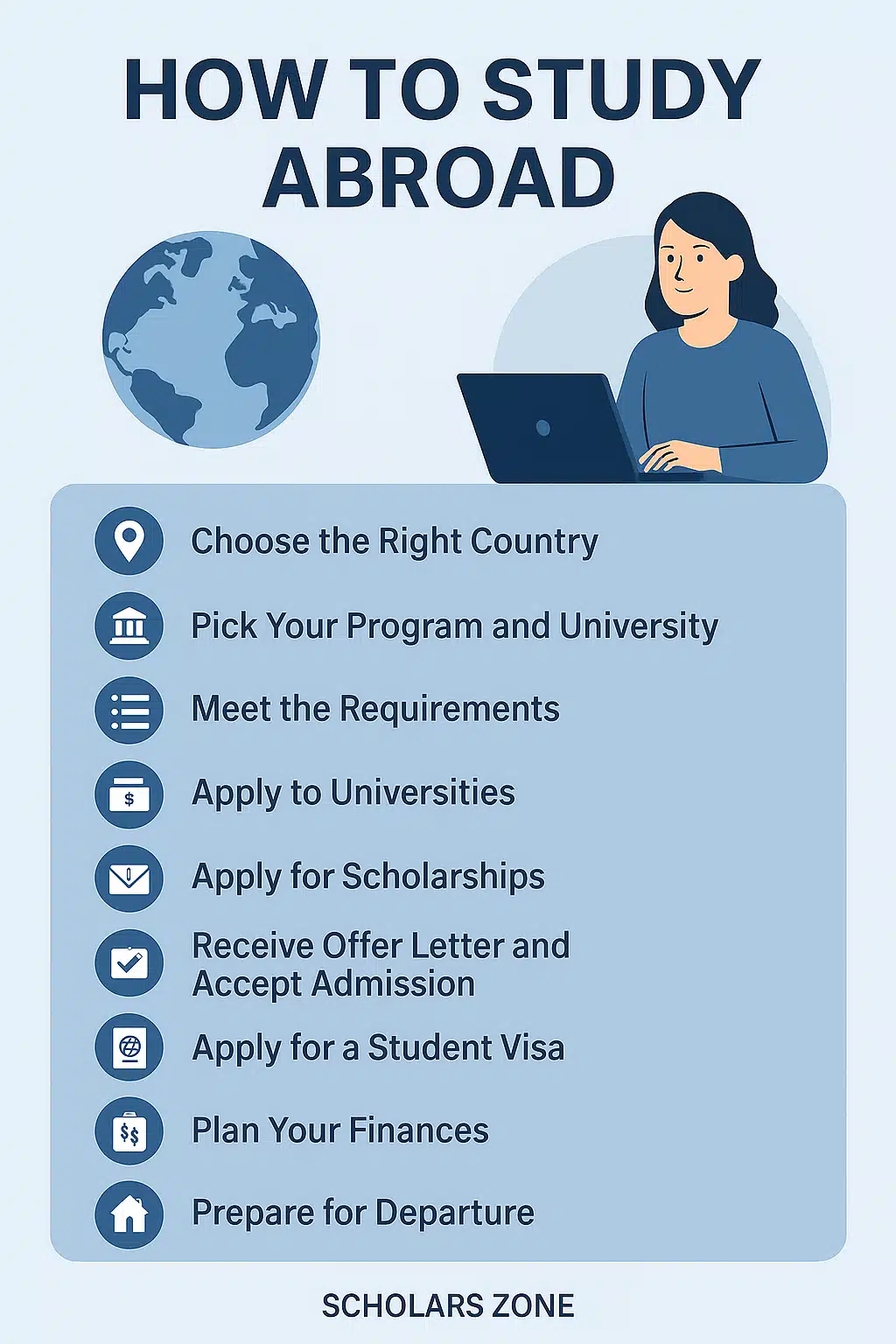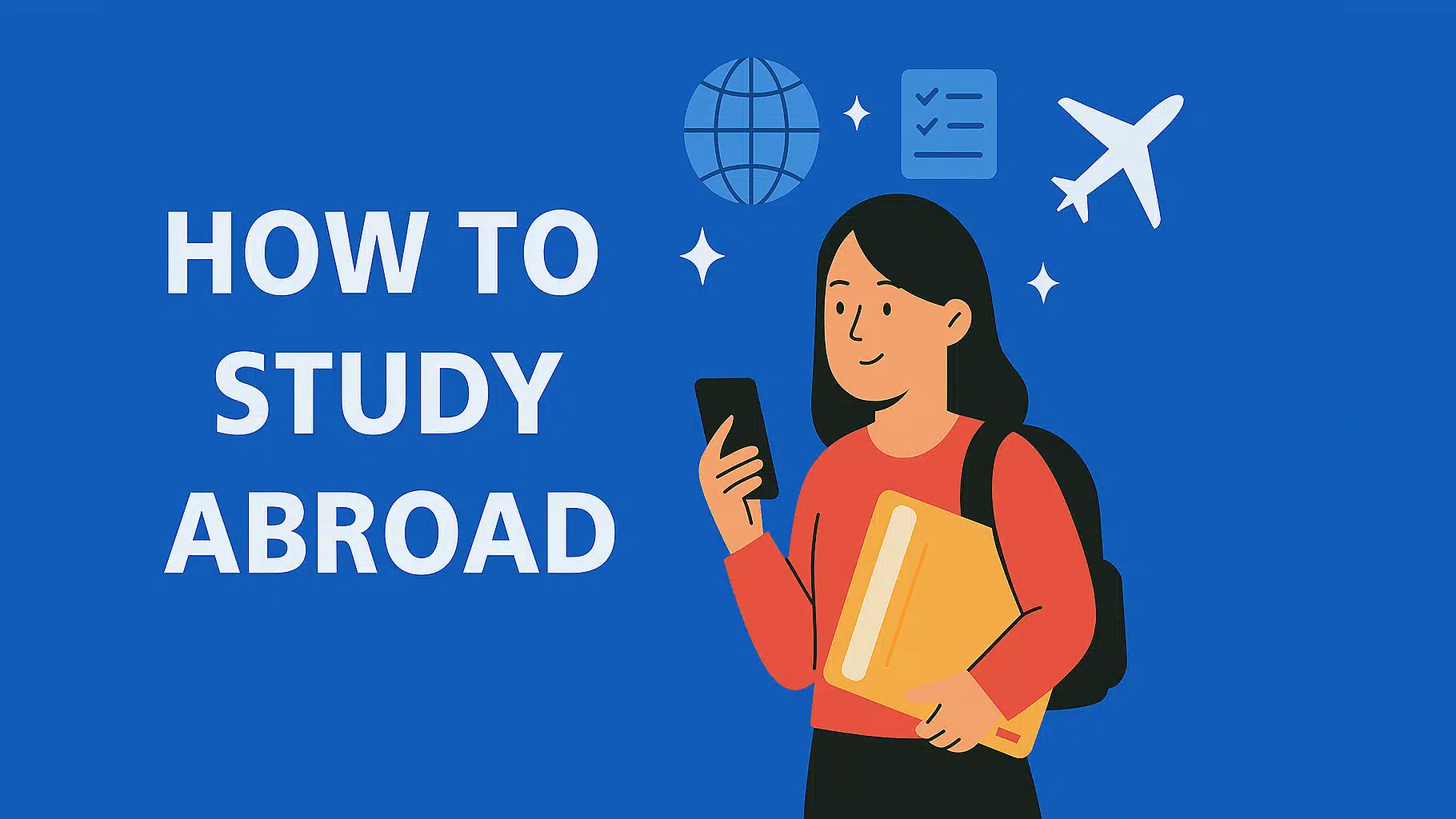
Whether you’re a high school student planning to study at a foreign university or a graduate looking to enhance your qualifications, this guide covers everything you need to know about studying abroad — from choosing a destination to securing a visa and managing finances.
Why Study Abroad?
Before diving into the logistics, let’s explore the benefits of international education:
-
Global recognition of degrees from top universities
-
Cultural immersion and personal development
-
Language proficiency improvement
-
Networking opportunities across borders
-
Access to better job markets and PR (Permanent Residency) pathways
How to Study Abroad: Step-by-Step Process
Here is a comprehensive roadmap to help you prepare for your study abroad journey:
Step 1: Choose the Right Country
Choosing the best destination depends on your budget, academic goals, preferred lifestyle, and long-term plans.
Top Study Abroad Destinations:
-
Canada – Post-study work rights, high-quality education, PR opportunities
-
Australia – Multicultural environment, globally ranked universities
-
United Kingdom – Shorter degree duration, rich academic history
-
United States – Innovation and research leadership
-
Germany – Low to no tuition fees, especially for STEM
-
New Zealand – Safe and scenic, student-friendly policies
Tips:
-
Check language requirements (IELTS/TOEFL/PTE)
-
Look at visa conditions and part-time work options
-
Consider living costs and scholarship availability
Step 2: Pick Your Program and University
Once you’ve selected your country, research the best courses and institutions aligned with your career goals.
Popular Programs for International Students:
-
Engineering (Mechanical, Electrical, Software)
-
Business & Management
-
Health Sciences & Nursing
-
Computer Science & IT
-
Hospitality and Tourism
-
Environmental Studies
Use ranking platforms like QS, THE (Times Higher Education), and official university websites to compare curriculum, facilities, and international student services.
Step 3: Meet the Academic and Language Requirements
To qualify for admission, you’ll need to submit:
-
Academic transcripts
-
Language test scores:
-
IELTS: Minimum 6.0 – 7.5 depending on course
-
TOEFL: 80 – 100 iBT
-
PTE: 58 – 65+
-
-
Statement of Purpose (SOP)
-
Letters of Recommendation (LORs)
For some programs (especially master’s and research), you may also need:
-
Resume/CV
-
Research proposal (for PhDs)
-
Portfolio (for creative courses)
Step 4: Apply to Universities
Most universities accept online applications directly through their websites or centralized portals (like UCAS for the UK or ApplyAlberta for Canada).
Pro Tips:
-
Apply to multiple universities to increase your chances
-
Track application deadlines (Fall, Winter, or Summer intakes)
-
Keep documents ready in advance, including notarized copies if needed
Step 5: Apply for Scholarships and Financial Aid
Studying abroad can be expensive, but there are plenty of scholarship options.
Types of Scholarships:
-
Merit-based scholarships
-
Government-funded scholarships (e.g., Chevening, DAAD, Australia Awards)
-
University-specific scholarships
-
Need-based grants and bursaries
Apply early — scholarship deadlines are often months before the program start date.
Step 6: Receive Offer Letter and Accept Admission
If selected, you’ll receive a Conditional or Unconditional Offer Letter.
Next Steps:
-
Pay the required tuition deposit
-
Receive a Confirmation of Enrollment (COE) or Letter of Acceptance
-
Prepare documents for your student visa application
Step 7: Apply for a Student Visa
Each country has its own visa application process. Here’s a quick overview:
| Country | Visa Type | Processing Time | Key Documents |
|---|---|---|---|
| Canada | Study Permit | 4–12 weeks | LOA, proof of funds, IELTS, biometrics |
| Australia | Subclass 500 | 4–8 weeks | COE, OSHC, SOP, proof of funds |
| UK | Tier 4 Student Visa | 3–6 weeks | CAS letter, proof of funds, TB test |
| USA | F1 Visa | 4–8 weeks | I-20 form, SEVIS fee, Visa interview |
| Germany | Student Visa | 6–12 weeks | Admission letter, blocked account, insurance |
Step 8: Plan Your Finances
Average Cost Breakdown (Per Year):
| Expense | Canada | Australia | UK | USA |
|---|---|---|---|---|
| Tuition Fees | CAD 15k–30k | AUD 20k–40k | £10k–£25k | USD 20k–45k |
| Living Expenses | CAD 10k–15k | AUD 21k–27k | £10k–15k | USD 12k–18k |
Options to Manage Costs:
-
Scholarships
-
On-campus or part-time jobs
-
Student bank accounts with low fees
-
Affordable housing (shared apartments or hostels)

Step 9: Prepare for Departure
Once you receive your visa, it’s time to plan your travel and accommodation.
Checklist:
-
Book flight tickets
-
Arrange student housing
-
Buy health insurance
-
Carry original and digital copies of documents
-
Attend pre-departure orientation (if offered by your consultant or university)
Step 10: Arrive and Settle In
Upon arrival, be sure to:
-
Register with your university
-
Get your student ID and open a local bank account
-
Activate your mobile SIM and transit card
-
Attend orientation programs
-
Explore your city and connect with student communities
Bonus Tips on How to Study Abroad Successfully
-
Start planning at least 12–18 months in advance
-
Seek help from education consultants
-
Stay updated on visa rules and deadlines
-
Practice your language skills
-
Be open to different cultures and new ideas
How Scholars Zone Can Help You Study Abroad
At Scholars Zone, we specialize in helping Bangladeshi students study in Canada, Australia, the UK, and more. From choosing the right university to securing your visa, we’re with you every step of the way.
📌HEAD OFFICE: House – 27/A, Rd No. #03, Dhadmondi, Dhaka – 1205.
🌐 Website: www.scholarszone.com.bd
📞 Phone: +88 01714-076485
📧 Email: contact@scholarszone.com.bd






